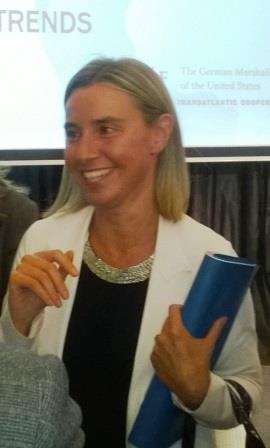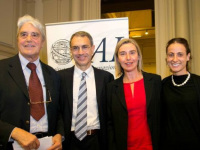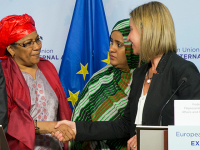Federica Mogherini, the Italian minister for Foreign Affairs and International Cooperation, launched the Transatlantic Trends 2014 Survey from 15:00 to 16:00 hrs.
The Italian Foreign Minister elaborated on chart 6 (page 15 of the report) highlighting the result of a broader enthusiasm in the Union for a global European leadership.
This has been a recurrent narrative throughout her intervention.
Further, she explained this sudden quest for a stronger engagement was the consequence of an increased awareness in EU of the fact that turmoil is nowadays more evident in the EU continent. She then pointed out that all the major crisis are taking place in the EU neighbourhood. She further confirmed this finding referring to the fact that there was no corresponding increase, in the same chart, in the American public despite the rise of tensions in the world.
The future EU’s high representative for Foreign Affairs and Security Policy and vice president of the European Commission also referred to global governance as a major theme. More in detail, discussing on EU and global stability she referred to a different “West-East model” based on an EU involvement more ambitious and humble at the same time. Ambitious in terms of engagement and more humble in terms of inclusion of other regional players.
The Transatlantic Trends is an annual survey exploring how Europeans and Americans view the transatlantic relationship and a number of challenges facing the world. Every year, in the first half of September, the results are presented simultaneously in all surveyed countries.
The polling are conducted in the USA, Turkey, and in 12 states of the EU: Germany, France, Great Britain, Italy, the Netherlands, Poland, Portugal, Slovakia, Spain, Romania and Bulgaria. Since 2011 Sweden has been included in the survey, and in since 2012 – Russia. The polling is performed through Computer Assisted Telephone Interviews (except in Poland, Slovakia, Turkey, Bulgaria and Romania where face-to-face interviews are conducted) in June. In all countries, a random sample of approximately 1000 men and women, 18 years of age and older, was interviewed. For results based on the national samples in each of the 14 countries surveyed, one can say with 95% confidence that the maximum margin of error attributable to sampling and other random effects is plus or minus three percentage points. For results based on the total EU sample, the margin of error is plus or minus one percentage point.





 10 Set 2014
10 Set 2014
 Inviato da Anthony Brown
Inviato da Anthony Brown 




















